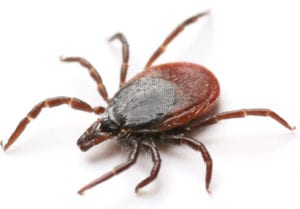Rose Pest Solutions brings you the 2020 Winter Gazette! The following article will help ensure that your home is protected from winter pests looking for shelter. Whether they’re hiding in the wood for your fireplace or a sweater found at the thrift store, we have tips you need to keep winter pests out.
Winter Pests and How to Avoid Them
Now that we are in the throes of winter, the allure of a roaring fireplace is hard to ignore. But the wood you bring in for your cozy fire can also bring unwanted hitchhikers. A variety of insects, arachnids, and other arthropods like to live in, on, and around stacked firewood. Some harmless (though undesired) insects include pillbugs, sowbugs, daddy-longlegs, spiders, earwigs, and springtails. The most problematic invaders are the carpenter ants and wood-boring beetles because these can damage your home.
There are several ways you can help reduce the likelihood of importing pest problems. If you have your own firewood supply outdoors, it’s best to stack it away from your house to discourage any of these creatures from wandering the short distance indoors for heat and shelter. Before bringing in firewood, make sure there are no bird or other animal nests on or near it. These nests can harbor mites, ticks, and fleas. Keeping your firewood tightly wrapped and covered can help reduce the number of winter pests inside it. Before you bring wood indoors, brush off any soil or debris first and use firewood very soon after you bring it indoors. The shorter the amount of time it is sitting inside, the less likely any pests will start moving off of it and into the recesses of your home.
It’s also important to remember that it is never advisable to transport firewood great distances or move it across state lines. The spread of invasive insects is rapidly expanding and is greatly aided by the movement of firewood. By taking these steps, you will be much less likely to introduce a pest problem into your home this winter.
Hickory, Dickory, Dock —Don’t Let a Mouse in Your Clock!
“Oh, rats!” may become more literal in the winter, rather than just an expression of something going wrong, as rodents look to escape colder temperatures. Rodents, such as rats and mice, can enter homes through the tiniest of holes. Mice can squeeze through a hole the size of a dime and rodents need only a quarter-sized hole.
Once inside, these invaders have everything they need to start breeding inside your home. First, harborage sites and possible food sources must be eliminated. Rats will use nearly any means possible to gain access to food, water and harborage. They are good climbers with excellent balance and can use wires, pipes, and even gutters to find entry points into homes. Rats are also very capable swimmers making them right at home along waterways and in sewers. There have even been reports of rats entering homes through toilets. When rats and mice frequent an area, they often leave behind clues such as droppings, urine, and gnawing damage. Other, more subtle signs can include tracks or runways, rub marks, burrows, and even sounds. These clues can be used to identify where rodents are feeding or nesting. Nests are commonly found in sheltered locations and usually consist of shredded materials such as paper, cardboard and insulation.
Rodents are dangerous pests capable of spreading dozens of diseases. When foraging rats and mice contaminate surfaces with their droppings and urine that can spread bacteria, contaminate foods and cause allergic reactions. Rodent bites are also a serious concern, with around 50,000 people bitten by rodents each year. These bites are most common among infants and the elderly and can spread disease or lead to a secondary infection.
Winter pests such as rodents can also cause extensive damage to your home. Gnawing damage to electrical wires can pose a dangerous fire hazard, while chewed water lines can cause leaks or even flooding. Rats and mice also cause considerable damage to insulation through tunneling, by tearing it apart for nesting materials or due to contamination from feces.
Check your home for signs of rodent droppings, gnaw marks, scurrying noises behind walls, and accumulation of shredded paper hidden in dark corners, indicating a nesting site. Addressing these conditions at the first signs of rodent activity is important to the success of any rodent management program. Preventing rats and mice from entering your home is also critical to avoiding an infestation. However, rodent-proofing your home is no easy task. If you do find rodent signs, the best approach is to call us to make sure rodents are quickly removed to ensure the safety and health of your family.
Macklemore, in his song “Thrift Shop” had some sage advice on thrift shopping and saving money. But, one thing he failed to mention in his popular song is to check fancy wool coats and sweaters for moth holes. Who hasn’t found little holes in their favorite cashmere cardigan or wool sports coat? It’s common this time of year to unpack your cold-weather clothes and find damage done by clothes moth larvae.
Fabric Pests to watch out for
There are two kinds of clothes moths encountered in homes — the webbing clothes moth and the case-making clothes moth. Their larvae will feed on any animal fibers containing proteins, including fur, wool, and wool blends, silk, hair, feathers/ down, mohair, cashmere, and more. You could find damage (or the larvae themselves) on woolen clothing, carpets, rugs, upholstered furniture, furs, stored wool, animal bristles in hairbrushes, and even woolen felts on piano keys. Synthetics or fabrics such as cotton may also be fed upon if they are blended with wool.
Damage generally occurs in hidden areas such as under collars or cuffs of clothing, in crevices of upholstered furniture, and in areas of carpeting covered by furniture. Fabrics stained by foods, drinks or perspiration, are usually more subject to damage. Clothes moths are weak flyers and are not attracted to lights. They tend to hide when disturbed, and for this reason, infestations of clothes moths are not usually noticed until damaged fabrics, furs, or feathers are found. Close examination of the objects reveals the presence of silken webs that are spun by the larvae as they begin to pupate. Because adult moths are weak flyers and not attracted to lights, they are usually found very close to the infested items, such as in dark areas of closets.
You can do a lot to prevent clothes moth damage by dry cleaning and then storing your valuable winter woolens and similar type of materials in airtight containers over the summer months. To reduce the possibility of infestations, periodically clean areas of a home that may harbor clothes moths. These areas include many seldom-cleaned spots, such as under heavy pieces of furniture, along baseboards, in cracks where hair and debris accumulate, closets, heaters and vents. The vacuum cleaner is the best tool for most of this cleaning. After using the vacuum in infested areas, promptly discard the bag in a dumpster outside.
Clothes moths may first become established on woolen garments or scraps stored for long periods. If such articles are to be saved, they should be stored properly, or periodically hung in the sun and brushed thoroughly, especially along seams and in folds and pockets. Brushing destroys eggs and exposes larvae. Larvae are strongly repelled by light and will fall from clothing when they cannot find protection. If these proactive measures do not work, then call us at 800-GOT-PESTS, and we can provide a trapping and mating disruption strategy as well as other materials known to be effective on clothes moths.
Active Ticks in the Winter
It’s unfortunate, but not all insects and arthropods die off in the winter like you may have hoped. Insects and ticks are cunning creatures that have adapted multiple ways to survive cold winter months. The blacklegged dog tick, in particular, is not killed by freezing temperatures. When temperatures are just above freezing and the ground is thawed out from the snow, ticks may still be active and searching for their next blood meal.
Ticks spread a multitude of diseases, including Lyme disease, babesiosis, anaplasmosis, Rocky Mountain Spotted Fever, among others. It’s important even in the wintertime to check yourself when coming indoors and to remove any ticks immediately from your body. You will want tweezers to grab the tick near the mouth parts and pull gently in an upward motion to remove the entire tick. If temperatures do begin to warm up and get above freezing and you will be spending time outside, especially
in wooded areas, it’s always best to be safe and apply a tick repellent.
Indoors, brown dog ticks can reproduce and cause an infestation so it’s important to remain vigilant with pets during winter as well. Keep your pets on tick preventative medicine and regularly check any pets that frequent outdoors for ticks. If you do suspect that you have ticks in your yard or in your home, don’t hesitate to give us a call to do a tick inspection and provide recommendations for keeping your home tick-free.
Some ticks remain active in winter so you should check yourselves and your pets when you come in from outdoors.
To remove ticks, such as the brown dog tick above, use tweezers to grab the tick near the mouth parts and pull gently in an upward motion to remove the entire tick.
Fear Not, We Have Your Back
To the untrained eye, some pest problems can be more challenging to identify and eradicate. Our professionals know just where to look to save you from your frustration. Rose Pest Solutions is here for you to get to the root of the problem and offer a solutions fit for the needs of your home. The Healthy Home Maintenance Program (HHMP), our most popular residential pest service, is the gold standard in home pest protection and prevention. This ultimate protection package involves four scheduled visits, once every three months, to ensure you have the peace of mind and safety that comes from a pest-free home. We stand by our services and their 24/7/365 protection 100%, so we’ll take care of issues that pop up in between scheduled visits at absolutely no cost to you. That’s right, we’ll come back out for free.
Give us a call today 800-GOT-PESTS to set something up so you can get back to celebrating the holidays without winter pests holding you back.






